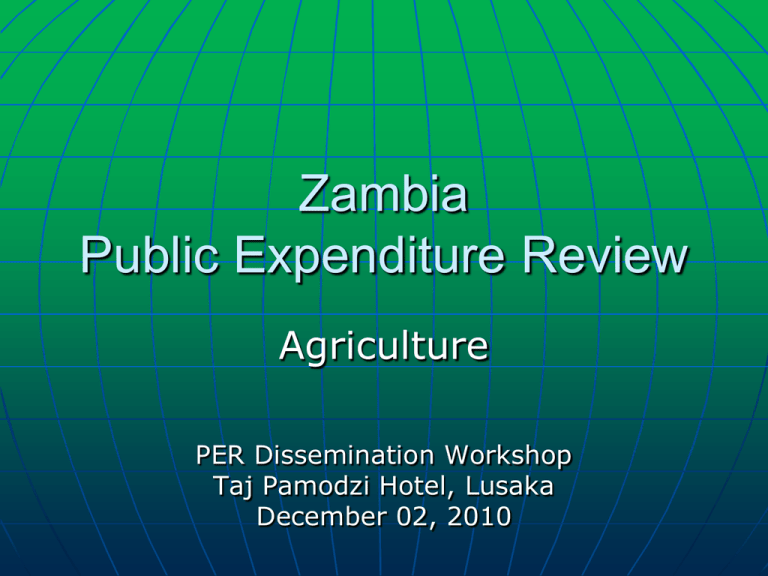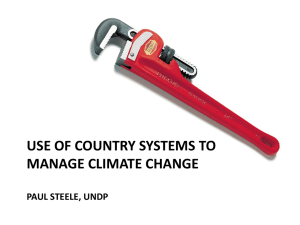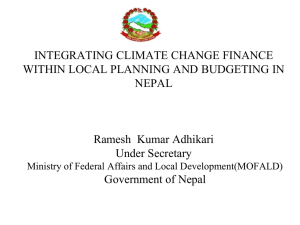Zambia AgPER - Economics Association of Zambia
advertisement

Zambia Public Expenditure Review Agriculture PER Dissemination Workshop Taj Pamodzi Hotel, Lusaka December 02, 2010 Public Expenditure Review in Agriculture Scope was to assist GoZ to critically review its operations and the use of public resources: • Identify opportunities to support fast and equitable growth in the Agricultural sector • Improve the effectiveness, quality, and equity in delivery of Agricultural services to the people of Zambia Not an audit of expenditures Agriculture in Zambia Abundantly endowed with minerals, land, and water About 70 percent of the Zambian labor force employed in agriculture. Primary source of income for the poor (productivity and profitability closely associated with poverty incidence) Contributes about 20% of GDP Despite the recent bumper maize harvest, sector has underperformed over the past decade; average growth (1.3%/yr lagged behind population growth of 3%/yr Agriculture in Zambia ctd. Underutilization of potential cultivable area (+/- 16 million ha) Rain-fed maize still dominates Zambia’s agriculture Disproportionate priority towards maize and fertilizer subsidy schemes. Irrigation is an integral part of the agenda to bring Zambia’s underutilized land into production. Agriculture in Zambia ctd. Opportunities for effective Government and donor support • Strengthening market mechanisms and value chains • Addressing critical policy issues in the agricultural sector • Investing in infrastructure Agriculture in Zambia ctd. Opportunities for effective Government and donor support • Strengthening market mechanisms and value chains Improved access information, to market and price • addressing critical policy issues in the Better market linkages and organization, agricultural sector Contract enforcement, Partnerships between the • investing in infrastructure private sectors in extension. public and Agriculture in Zambia ctd. Opportunities for effective Government donor support Poorly targetedand fertilizer subsidy, Price policy for wheat and maize, • strengthening market mechanisms Periodic export bans on key food staples. and value chains High cost of doing business (complex licensing regime) • Addressing critical policy issues in the agricultural sector • investing in infrastructure Agriculture in Zambia ctd. Opportunities for effective Government and donor support • strengthening market mechanisms and value chains Infrastructure needs in transport, energy, telecommunications, irrigation, etc. Requires prioritization and partnership with • addressing critical policy issues in the the private sector agricultural sector • Investing in infrastructure Agriculture in Zambia ctd. New developments • Fertilizer voucher program Pilot • Reintroduction of the Agriculture Marketing Bill Agriculture in Zambia ctd. New developments • Fertilizer voucher program Pilot Expected to increase private involvement in fertilizer distribution sector Should result in a gradual reduction of public fertilizer expenditure • Reintroduction of the Agriculture Marketing Bill Implementation has been delayed, however Agriculture in Zambia ctd. New developments • Fertilizer voucher program Pilot Designed to enhance smallholder farmers’ access to markets and to include warehouse receipting • Reintroduction of the Agriculture Marketing Bill Agriculture in Zambia ctd. Figure 1: Real GDP Contribution of the Agriculture Sector Real GDP contributions 250 200 billion 1994 ZMK 150 Agriculture Fishing Forestry 100 50 0 2001 2002 2003 2004 2005 2006 2007 2008 2009* Source: PER Authors on the basis of CSO data Agriculture in Zambia ctd. Figure 2: Maize production trends Maize Productivity (t/ha) Maize production 3.0 2,000 1,800 2.5 1,400 2.0 t/ha 1,200 1,000 1.5 800 1.0 600 400 0.5 200 0 Source: PER Authors on the basis of crop forecast data provided by MACO. Note: Line = three-year moving average 20 09 20 07 20 05 20 03 20 01 19 99 19 97 19 95 19 93 19 91 19 89 19 87 0.0 19 98 19 99 20 00 20 01 20 02 20 03 20 04 20 05 20 06 20 07 20 08 20 09 Thousand MT 1,600 Agriculture in Zambia ctd. Limitations of statistics agricultural production on • Post-harvest data have not been available since 2004 (lack of funding for data cleaning and processing) • CSO estimates based on pre-harvest surveys administered by MACO through its Early Warning System • Focus almost exclusively on staple crops • Livestock “production” is estimated on the basis of animal stocks rather than slaughters • Chicken production not taken into account Public Expenditure in Agriculture Origin of Fiscal Data • Analysis based on the “Estimates” (“Yellow Book”), and the “Financial Reports” (“Blue Book”) • Budgets and financial reports from 2004 onwards • Approved Estimates were available up to 2010 • Last available 2008 Financial Reports from Public Expenditure in Agriculture ctd. Figure 3: MACO spending by “core” and “FSP and FRA” in constant Kwacha MACO spending, constant 2008 ZMK 900 800 Constant ZMK billion 700 600 500 FSP and FRA 400 Core MACO expenditure 300 200 100 0 20 00 20 01 20 02 20 03 20 04 20 05 20 06 20 07 20 08 20 09 20 10 Source: PER Authors on the basis of Estimates and Financial Reports Note: Red Line = data source switches from actual expenditure (up to 2008) and budget (2009 and 2010) Public Expenditure in Agriculture ctd. Table 1: Global government spending, 2004-2008 million K 2004 2005 2006 2007 Tax and non-tax revenue /1 4,535,704 5,425,980 6,291,261 8,198,276 9,666,888 Total spending as per Financial Report 5,993,217 7,266,854 7,729,459 9,798,711 12,348,787 Debt service internal 745,524 608,894 578,422 469,998 497,536 Debt service external 597,989 470,184 227,019 239,180 222,135 Defense 538,147 625,791 690,140 899,134 1,013,235 Recapitalisation, Investments and Government Institutions under Loans and Investment 124,123 145,391 168,350 219,164 186,848 Core-MACO 236,749 91,500 332,400 133,281 446,838 122,792 636,376 227,078 735,985 194,165 FSP and FRA 145,248 199,118 324,046 409,298 541,820 100.0% 100.0% 100.0% 100.0% 100.0% Debt service internal 12.4% 8.4% 7.5% 4.8% 4.0% Debt service external 10.0% 6.5% 2.9% 2.4% 1.8% Defense 9.0% 8.6% 8.9% 9.2% 8.2% Recapitalisation, Investments and Government Institutions under Loans and Investment 2.1% 2.0% 2.2% 2.2% 1.5% Agriculture (Head 89) 4.0% 4.6% 5.8% 6.5% 6.0% 1.5% 1.8% 1.6% 2.3% 1.6% 2.4% 6,189,281 2.7% 6,947,082 4.2% 7,904,334 4.2% 9,678,320 4.4% 11,295,249 Agriculture (Head 89) 2008 in % Total spending as per Financial Report Core-MACO FSP and FRA Memo: total internal budgeted expenditure Source: Financial Reports 2004-2008 Note: Tax and non-tax revenue according to the narrative section of the Fin. Reports Public Expenditure in Agriculture ctd. Figure 4: Core MACO spending by broad groups of departments, in constant Kwacha Core MACO spending, constant 2008 ZMK 400 350 300 250 200 150 100 50 0 20 00 20 01 20 02 20 03 20 04 20 05 20 06 20 07 20 08 20 09 20 10 Constant ZMK billion Districts Provinces Training and research Central sections of MACO Public Expenditure in Agriculture ctd. Figure 5: Spending by provincial and district agricultural offices Spending at the Provincial and District Levels 200 180 160 140 120 Districts Billions of Constant ZMK 100 non-PE Province Personnel 80 60 40 20 0 2005 2006 2007 2008 2009 2010 Based on Financial Reports 2005-2008) and Approved Estimates (2009 and 2010). Note: Personnel costs in provincial budgets also include salaries for staff at district offices. Public Expenditure in Agriculture ctd. Table 2: Spending and execution rates by provincial and district agricultural offices 2005 Actual Total spending Province and District level Provinces Personnel non-PE Province Districts Non-PE total 2006 Actual 2007 Actual 2008 Actual constant million Kwacha 2009 2010 Budget Budget 95,431 86,233 133,885 103,981 194,648 162,601 72,301 66,292 6,009 23,130 29,139 75,140 69,981 5,159 11,093 16,252 90,705 75,491 15,214 43,180 58,394 82,649 72,941 9,707 21,332 31,040 108,125 75,830 32,295 86,524 118,819 99,974 79,159 20,815 62,627 83,441 Non-PE as % of total province and district spending 30.5% 18.8% 43.6% 29.9% 61.0% 51.3% Non-PE total assuming 60% execution for 2009 and 2010 29,139 16,252 58,394 31,040 71,291 50,065 8.5 88.9 5,109 4.2 100.0 16.9 113.4 12.3 124.7 No of provincial and district-level staff Nov 2008 District spending per staff 4.5 CPI, 2008=100 73.7 2.2 80.4 Source: Financial Reports and Budget figures. Staff level in 2008 from Cardno Agrisystems Ltd 2009 (Participatory Review). Public Expenditure in Agriculture ctd. Figure 6: Direct technology spending relative to MACO core spending Direct technology spending relative to other MACO expenditure 25% % of core MACO spending 20% 15% Training Institutes Research stations ZARI 10% 5% 0% 2002 2003 2004 2005 2006 2007 2008 2009 2010 Public Expenditure in Agriculture ctd. Table 3: Budget execution rates for non-personnel expenditure 2004 Non-personnel execution rates Total MACO core 2005 2006 2007 2008 61% 82% 59% 66% 67% 53% 27% 64% 87% 74% 72% 86% 88% 64% 40% 39% 38% 77% 70% 61% 58% 67% 70% 77% 61% 53% 82% 69% 33,193 59,259 40,002 128,784 84,130 Provinces Districts Research incl. research stations Training Institutes Other Headquarter Non-personal emoluments budget Total MACO core 0 0 2,424 621 30,148 4,430 17,051 3,730 3,326 30,723 4,146 8,915 2,017 1,387 23,537 13,530 38,401 11,918 4,454 60,481 9,707 21,332 5,860 6,309 40,922 54,175 72,310 68,183 195,294 125,988 Provinces Districts Research incl. research stations Training Institutes Other Headquarter 0 0 4,606 2,285 47,284 5,086 23,172 5,215 3,879 34,958 6,491 22,103 5,207 3,647 30,735 19,238 62,843 20,704 6,684 85,824 12,648 35,030 11,078 7,674 59,558 Provinces Districts Research incl. research stations Training Institutes Other Headquarter Non-personal emoluments actual Total MACO core Public Expenditure in Agriculture ctd. Table 4: Comparison of internally and externally financed appropriations and reported expenditure K mn 2006 2007 2008 2009 Budgeted Internal External Reported Budgeted Internal External Reported Budgeted Internal External Reported Budgeted Internal External 210,959 10,651 200,308 10,506 360,594 5,058 355,537 34,050 277,311 16,223 261,088 35,561 158,346 3,350 154,996 Exchange Rate 3,603 4,003 3,746 5,046 USD Thousand 58,550 2,956 55,594 2,916 90,092 1,264 88,828 8,507 74,035 4,331 69,704 9,494 31,380 664 30,716 Note: The table reports on planned and actual spending under the Unit for Bilateral, Multilateral and Regional Cooperation in MACO. Only those programmes in which footnotes for external funds appear were selected. Public Expenditure in Agriculture ctd. Donor Contributions • Focus on extension and farming systems • International cooperation projects with ZARI • Donor funded projects poorly reflected in budgets ad financial reports Public Expenditure in Agriculture ctd. Conclusions • Overall agricultural spending appears sufficient, but majority of these resources goes to large-scale subsidy programs. Need to consider retargeting expenditures towards core agricultural services • CSO has adequate resources to collect data, but not to process them • Need to reduce annual and in-year variability of agency budgets, uncertainty leads to weak budget execution Gender and Public Expenditure in Agriculture The Importance of Gender in the Agricultural Sector • Females make up about 70 percent of the agricultural workforce • Gender mainstreaming is essential to the longterm growth of agricultural productivity and sector revenue, and inseparable from the alleviation of rural poverty. • Women, especially in rural areas, are still constrained by a lack of access to inputs, productive resources, and public services. Gender and Public Expenditure in Agriculture ctd. Laudable GoZ efforts to incorporate a strong gender element into development programming, not limited to agriculture (FNDP 2006-2010, National Gender Policy, signatory to several international declarations, conventions, etc.) But… Economic empowerment of women and the mainstreaming of gender into agricultural policies and programs remain inadequate in scope and ineffective in execution. Gender and Public Expenditure in Agriculture ctd. Laudable GoZ efforts to incorporate a strong gender element into development programming, not limited to agriculture (FNDP 2006-2010, National Gender Policy, signatory to several international declarations, conventions, etc.) But… Economic empowerment of women and the mainstreaming of gender into agricultural policies and programs remain inadequate in scope and ineffective in execution. Gender and Public Expenditure in Agriculture ctd. Gender in Development Division (GIDD) of the Cabinet Office Gender Focal Points in Line Ministries Gender Sub-committees Gender and Public Expenditure in Agriculture ctd. Gender in Development Division (GIDD) of the Cabinet Office Mandate to coordinate, monitor, and evaluate the implementation of the National Gender Policy in Gender Focal Points in Line Ministries order to achieve gender-reflective goals in overall development policy In 2008, Sub-committees GIDD had an approved budget for gender Gender training of Gender Focal Points and members of the Gender Sub-committees of almost ZMK122 million but only ZMK 300,000 was actually disbursed... Gender and Public Expenditure in Agriculture ctd. Gender in Development Division (GIDD) of the Cabinet Office Gender Focal Points in Line Ministries Specific duties of the Gender Focal Points (GFPs) Gender are oftenSub-committees unknown to agency staff GFPs are rarely consulted on new initiatives Interagency collaboration between GFPs, though mandated by the GIDD, is extremely limited. Gender and Public Expenditure in Agriculture ctd. Gender in Development Division (GIDD) of the Function as a link between the GIDD and the Cabinetministries Office various as well as local and regional authorities. Reporting and oversight does not function Gender Focal Points in system Line Ministries well, collaboration with GIDD has been limited Gender Sub-committees Gender and Public Expenditure in Agriculture ctd. Limited, irregular and occasionally irreconcilable data on the role of gender in agricultural productivity Failure to collect, process and publish reliable, high-quality gender-disaggregated data on key sector indicators Gender and Public Expenditure in Agriculture ctd. Weak budget execution of gender specific programming and data collection “In 2008 MoFNP had an approved budget of over ZMK35 million for the collection of gender statistics, but actual expenditure was only ZMK1.8 million.” Gender and Public Expenditure in Agriculture ctd. Conclusions • Mainstreaming gender into the budgetary process is critical to achieving the government’s stated objectives for the agricultural sector • Need to consider reorganization of the MACO and MoFNP budget processes to reflect the appropriate prioritization of gender-specific programming, including data collection and analysis. Thank you!








